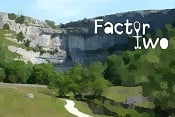
Screamers don't convince me. I don't like the amount of space they use up on the rack. I've never felt need to use them although I will soon be abroad with someone who always brings a couple of screamers every trip.
Has anyone ever fully tested these one-use accessories in a real life fall?
Do tell - and advise on best way of using them.
I've used screamers on marginal gear many times.
I've then done the sensible thing and not fallen on it!
One stopped a 20m fall when 2 ice screw failed and the one that held had a screamer. On another occasion one ripped then held a fall on Point 5 and all was well. I use them all the time especially on my first 3 to 4 ice screws. I have even used them on small cams as a head boost. I have used them when leaving a belay in Scotland when the next piece of gear is not obvious. A bit contentious this but at least the belayer knows where the pull will be from. When I first started out I was always told to use one on brass nuts but more dynamic ropes has helped reduce the impact force on gear
In reply to:
Some actual science on this link. They can reduce peak force by 26% or 1.5kN. A marginal gain.
https://eu.blackdiamondequipment.com/en_GB/qc-lab-to-screamer-or-not-to-scr...
Used one recently on thin early season ice on a mixed climb in Canada. Screamer was on a stubby (10cm) screw & I also placed a tied off 13cm screw as back up. I fell & the stubby blew but the screamer deployed, so I think it might have taken some of the force off the next piece, the tied off screw, which held. Don’t use them very much but when ice is not solid or the position warrants it (first piece off the belay etc) they make sense.
We ripped plenty when we climbed on chalk on the south coast. They do work, but are expensive if you keep falling, and in winter, they are a faff as they use to get soaked and then freeze and become big lumps of heavy ice. I use a version by e-climb which uses dynema and a alu plate, much lighter and re-usable
I've fallen about a body length onto one on an ice screw. It about half deployed which was interesting to see.
> Some actual science on this link. They can reduce peak force by 26% or 1.5kN. A marginal gain.
I think marginal is too weak a word for 26% difference
They could make the difference between living or dying!
The problem is, you'd never know. To be sure they helped in a certain situation you'd have to accurately assess how strong the placement was, and what peak force your fall would create - both almost impossible in the field.
Saying that you know they worked 'cos you ripped some is plain wrong, I'm sure I could rip them on every sports climbing fall I take - it doesn't mean they make the difference.
Some more examples from Yates here; although persons more qualified than me are very skeptical of their figures. http://www.yatesgear.com/climbing/screamer/use.htm
I'd like to see some test results of screamers in series.
And using dmm revolvers to reduce impact force.
Thanks all, for your thoughtful comments. The data tables make interesting reading. I may well use those screamers next time I place ice screws.
Remind me to ask you about that, sounds exciting!
I was at the final belay on Professor Falls, Mt Rundle, and watched an Italian climber attempt the pitch via the right hand fringe. He placed a good ice screw with a 'Yates' screamer on it before launching out. About 4 body lengths higher he started trying to place another screw in a strenuous position and got totally frazzled - a full minute of increasing panic and then came the fall. The screamer fully deployed and the runner held. The Italian chap was ok, but went to the airport the next morning!
I carry two - one for the first screw and one for something later that one wishes were better. A little, yellow plastic-covered Yates one for the first and a longer Yates one for elsewhere
Refer to Chris Tan death products, equipment. Not sure if Chris has used them though I suspect he may have control tested them.
Another useful shock absorber is "any bulk knot at all" in a longer sling or an equalised belay, and the more the merrier. Extending that thinking, what about using a twisted and racked 120 or 240cm sling clipped short (as you might rack it) as a screamer. Or, neater, a daisychain coiled sling?
I once saw a soloist take a monster fall on Zodiac on El Cap. He unzipped almost half a pitch and the one piece that held him had a deployed screamer on it.
Pretty cool, but like someone else said, we'll never know if that piece would've held anyway without the screamer.
E
Years ago, a much younger me tried to ground up The Enchanted Gordon (E6 7a). First go, I whipped on to the stacked peg, fully opening out a DMM screamer.
Second go, fell one move higher on to the now open screamer with no shock absorption and the peg ripped, depositing me on my ass from 20ft and causing huge bruising, and a cut head but luckily nothing more serious.
On this sample of n=1 I'm inclined to believe screamers work - I do bugger all sketchy trad and winter climbing now, but would happily carry and deploy screamers should i do these types of climbing again.
I applaud your commitment to turning anecdote into data.
I've used screamers on thin Scottish ice and chalk in the past, but I don't climb much of that any more. Never bothered on water ice as the racking becomes too messy and screws are rarely that marginal.
That's a bit harsh isn't it. The OP asked for real life experiences .... Various people have given experiences but were knocked back with "ah but it would have help even without the screamer"
At which point someone rocks up with exactly what the OP was asking for..... And you diss him
Besides which, he took what sounded like a horrific ground fall and was only saved by landing on top of a strategically placed donkey. I mean what are the chances of that....
> I'd like to see some test results of screamers in series.
> And using dmm revolvers to reduce impact force.
I'm intrigued. Why would a revolver reduce impact force? I'd have thought it would increase it
A revolver might allow more rope stretch, so extending the impulse time at less peak force for a given change in momentum. Friction will always serve to tighten up the system giving a less dynamic arrest, which is a bad thing.
In reply to:
If anyone is 'very' interested in screamers, then they should look up the mountainproject thread called yates-screamers-obsolete-or-niche?
It has all sorts of interesting bits of theory, and ends when Yates makes a cameo appearance and is robustly challenged by Jim Titt of this parish.
Thanks for that, it's an interesting read. I'm not sure they really get onto the point of addressing the roll of rate of loading and of avoiding shock loads in fall arrest. They're obviously very hard to measure in the real world and I suspect we survive because a host of non-laboratory factors reduce fall factor impulses to physiologically bearable values a lot lower than the test figures. Time is the factor that's not usually discussed.
With dyneema replacing nylon for slings (and better-holding ice screws?), avoiding shock loading has become more important than it used to be. DMM published this article -
https://dmmclimbing.com/Knowledge/June-2010/How-to-Break-Nylon-Dyneema%C2%A...
Dynamic belaying is the best answer to minimise the peak load on all the kit, given an on-the-ball belayer and sound runner. From the point the belayer starts to brake - usually one runner will take the brunt of the fall load, two if you're on double ropes and lucky with placements. Then the sequence of loading looks like:
1 Rope(s) tighten(s), engaging some friction with runners or rock depending on routing
2 Slings to protection align with any load and tighten, Carabiners align with load, Harness tightens on leader.
3 Wires, Nuts, slings, screw eyes, etc shift as they align with load; ;
4. Rope stretches, knots tighten, slings stretch, screamers scream (both kinds), ice deforms, metalwork bends, belay device heats up, belayer moves intelligently. All hopefully within their safe limits
In this whole system of moving things the screamer sling adds a fraction of a second (3/10 maybe? -the duration in the mountain project thread graph) of delay in a load ramping up from 0 to maximum. Something to help the dyneema components survive? Or the brittle ice?
The physical effects of rate of application of a load -in metallurgical terms and in elastic textiles and even in ice crystal morphology -often deliver a tensile strength benefit through allowing time for the material to respond elastically. So while the effect might be very hard to quantify and the situation hard to replicate, my money is on using a screamer when I'm dealing with a 'brittle' system that could do with some sponginess added. That way everything gets a marginally easier ride - tumbling leader included. It could just extend the duration of time over which the energy is dissipated throughout the system enough to make a critical differnce.
This is a bit of a strange argument. 26% difference means that for some falls they will definitely have made a difference between the gear ripping or not. Of course we don't know which falls since we can't turn back time and try again without the screamer... obviously! But the point is that since we know that sometimes they will make a difference, given the right circumstances, they are another line of defence, albeit a weak one, between you and the ground. If climbers didn't appreciate a marginal improvement in their chances from time to time, they wouldn't place crap RPs, turf pro etc.
I've acknowledged that they have an effect and provided good data for it!
An effect that could have very significant consequences, in the small minority of falls where it would make a difference. In the other falls you would have been ok anyway, or you'll be seriously injured. This isn't an argument against them, just realistically assessing their worth.
OK fair enough
> That's a bit harsh isn't it. The OP asked for real life experiences .... And you diss him
I ain't no snowflake - Dan's comment made me chortle.
> Besides which, he took what sounded like a horrific ground fall and was only saved by landing on top of a strategically placed donkey. I mean what are the chances of that....
Back in 2001 donkeys were far more readily available than bouldering mats are nowadays
Always carry some in winter.
Have the Fixe 15mm dyneema versions, short, neat and very compact in comparison to the frankly gigantic Yates or petzl shock absorbers. Mammut also made some that were very similar but sadly no longer available.
Never tested them and don't ever plan to. In my mind the concept works and coupled with low impact force ropes they provide quite some reassurance.
https://www.fixeclimbing.com/en/sport-climbing/cintas-via-ferrata/
Just checked, and the screamer I use is a DMM Shocktape, but I've just realised it must be 24 years old. Never been loaded though! Only image I can find online is on US eBay if you Google for it. Pity, as they're pretty low profile by comparison with current offerings.
I fell on a 10cm screw last winter, the screamer ripped and I was glad for it. Thankfully the route was overhanging so i fell into air
Laughing.......you may not want to but we know a man who does. After his 20m fall I had to purchase a new helmet. Pack you tightest undies for Senja . The corner will still be there... see you in a few months
Unfortunately we do! Looking forward to it
I was belaying Chris when he tested one of those. The gear still ripped, but by that stage the improvised screamer had stretched so much he was only a couple of feet off the ground.
Elsewhere on the site
Winter Conditions
This Winter Conditions page gives a summary of what is being climbed at the moment, what is 'in' nick and what the prospects are...








